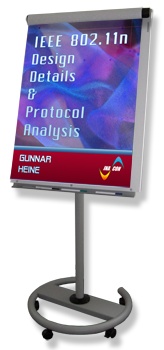 IEEE 802.11n - Design Details & Protocol Analysis
IEEE 802.11n - Design Details & Protocol Analysis
[2-day course, Euro 2,350.- (net) per participant]
 Training Course Description
Training Course Description

- This course describes in detail HT-related enhancements which the IEEE specified in the 802.11n extension of the WLAN / WiFi standard series.
- Starting out with a primer on "before n", the course initially focuses on 802.11 operation with respect to channel access and resource sharing. Namely the different channel access functions DCF, PCF, EDCA and HCCA are repeated and their differences and specifics are pointed out.
- During this part, the course also repeats the most important other characteristics of the OFDM-PHY and the MAC-layer. This includes a detailed consideration as to how QoS is enabled in 802.11.
- The following chapter starts with an overview of the different groups of features which are added by the "n"-extension of the standard. After this initial overview, this chapter already discusses in detail enhancements like "Short GI" (Guard Interval), more subcarriers, enhanced channel coding, new power saving modes (namely SM Power Save and PSMP) and the new RIFS (Reduced InterFrame Space).
- After this, the course focuses on the description and discussion of smart antenna techniques, namely MIMO, beamforming and STBC. The students will learn without needing any mathematical formulas, how these techniques work and how they are applied in 802.11n.
- Another section deals with the discussion of the "HT-Capabilities" information element and its contents. Target is to enable the students to more efficiently evaluate related logfiles during their daily work.
- The chapter concludes with a review of all "n"-related features but with a new focus: .Which features are mandatory or optional according to the IEEE and to the WiFi-alliance. This part is particularly interesting for those who require information regarding device certification.
- The next chapter is dedicated to all PHY-related aspects of 802.11n that have not been discussed yet. This includes features like 40 MHz-operation, PCO (Phased Coexistence Operation), PLCP-PDU types for greenfield and mixed operation, beamforming feedback and antenna selection.
- The MAC-related chapter starts with pointing out the differences in the MAC-frame structure with respect to new information elements and new Action-frame types. Focus is however on the presentation and detailed description of the new aggregation features of 802.11n. Both options, A-MPDU and A-MSDU aggregation are described in all detail. This includes a comparison of the two methods with respect to performance.
- This chapter continues with the detailed discussion of the BlockAck-feature or rather the improvements that have been introduced with 802.11n. This part includes the evaluation of a real-life BlockAck-session through the students.
- The MAC-chapter ends with a detailed description as to how scheduled PSMP operates.
- The final chapter of this course is dedicated to advanced security mechanisms of WiFi, namely EAP-based mechanisms, Fast Reconnect and Pre-Authentication. Please note that this chapter is no longer part of the 2-days course but is kept in the book as bonus material!
- This chapter starts with a primer on legacy security mechanisms in WiFi which relates to WEP, WPA and WPA2 and points out the differences among those.
- After this, we discuss two EAP-procedures (EAP-TLS and EAP-AKA) in full detail and we point out, how the 802.11-key material is finally generated after applying either of these two EAP-procedures. This section includes the practical evaluation of an EAP-logfile through the students.
As in all INACON courses we integrated several interactive exercises for a perfect learning experience. Many of these exercises are based on already prepared WIRESHARK logfiles which are provided to the students by the trainer. For those who don't have a PC with them or who do not use WIRESHARK, the logfiles are made available as printouts.
Some of your questions that will be answered
- How does WiFi support the distinction of different QoS-requirements?
- What are the various 802.11n-related enhancements?
- How do MIMO, STBC, antenna selection and beamforming work?
- How does an access point communicate which of the so called HT-features it supports?
- How does the OFDM-specific PPDU-format change with 802.11n?
- What are the specifics of channel bonding?
- What is greenfield operation?
- When is 40 MHz operation possible and when not?
- Which changes and modifications does 802.11n require in the structure and format of the different MAC-frames?
- How exactly do A-MPDU and A-MPDU aggregation work and how do they differ from each other?
- What changes have been added to the BlockAck-procedure with 802.11n and which improvements do those changes offer?
- How do security procedures operate in 802.11 in general?
- Which additional gain is provided by EAP?
- How do different EAP-procedures like EAP-TLS or EAP-AKA work?
- What is pre-authentication and how does it work?
 Who should attend this class?
Who should attend this class?
- Test engineers who need to understand the 802.11n-features and their implications in detail.
- Designers of 802.11n-equipment who require a deep inside view of the various enhancements.
 Pre-Requisites
Pre-Requisites
- The student must possess a thorough understanding in wireless and/or cellular communication technology before coming to this course. This knowledge should stem from multiple years of design or test experience with these technologies.
- At the least, we recommend our webinars or web based training courses WiFi to be taken beforehand.
 Training Course Target
Training Course Target
- The student is enabled to develop, test and integrate 802.11n-equipment and to operate related networks.
 Training Course Duration
Training Course Duration
- 2 days
v2.000
ℹ️ Try out the updated search below!
Search:
More Info:
Detailed ToC of this training course
Schedule of this training course
Extract of this training course
Buy this book
INACON eBooks
Please have a look at our full offer

